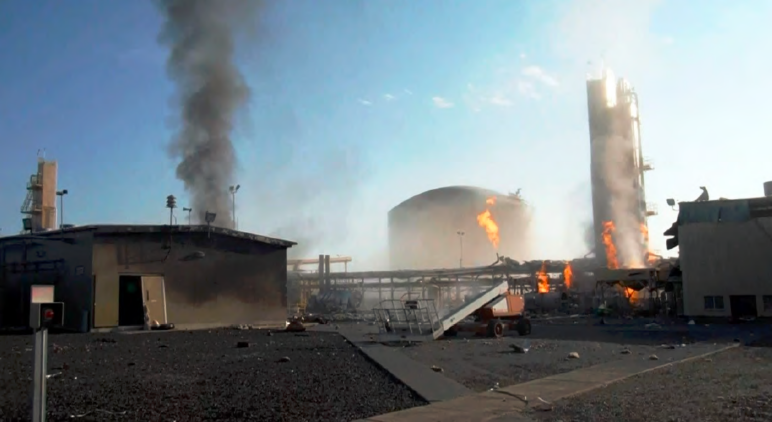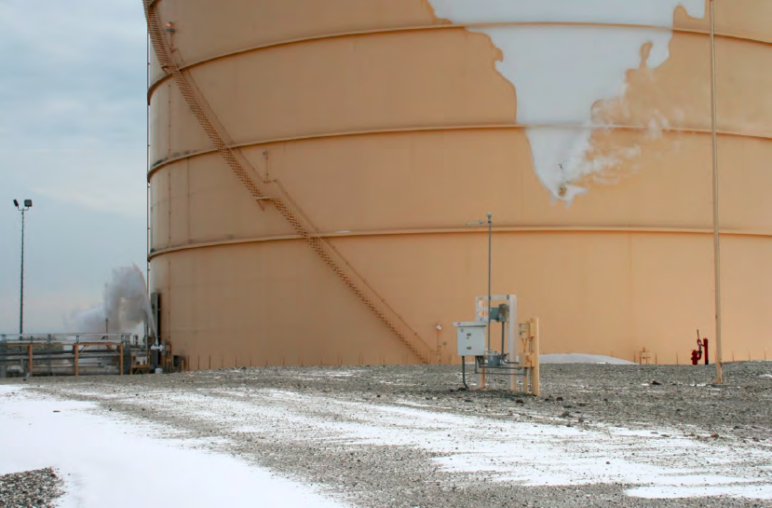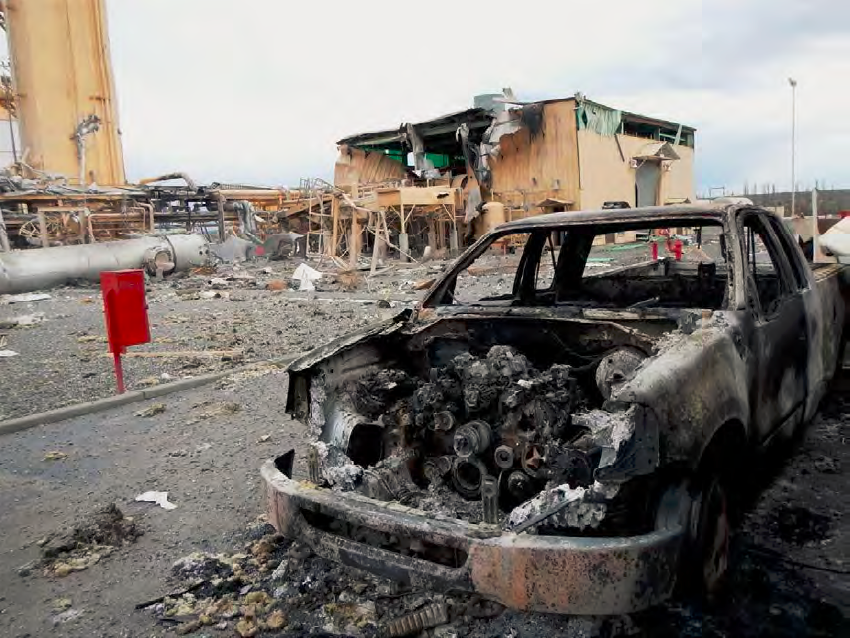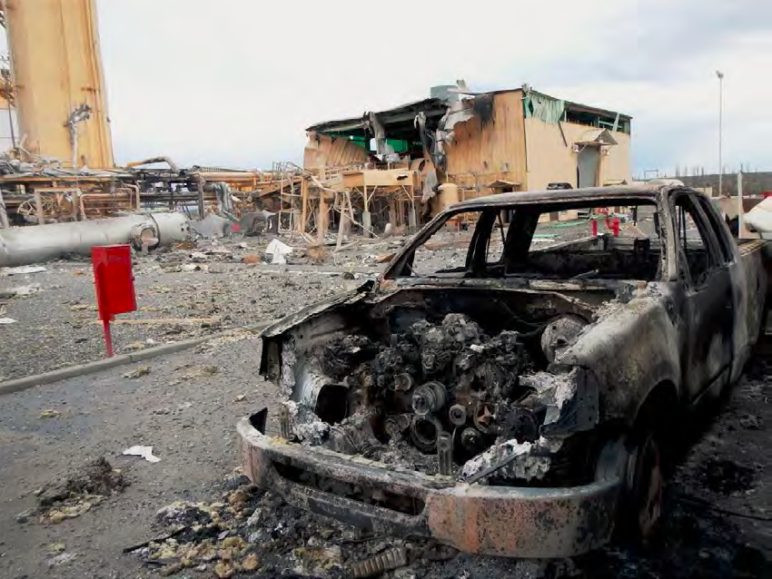Two years ago, an explosion at a liquefied natural gas (LNG) plant in eastern Washington forced hundreds to evacuate their homes, injured five workers, and caused $69 million in damages. It was one in a string of accidents at The Williams Companies’ natural gas facilities that in the last three years has killed five workers and injured at least 120 people.
Through a public records request, Sightline obtained documents from the Washington Department of Labor and Industries (Washington L&I), which conducted an investigation into the safety of employees at the Plymouth plant where the explosion occurred. The agency found that Williams endangered its employees, lacked an adequate emergency response plan, and had deficient safety training. The company’s track record—not just in the Northwest, but throughout the US—reveals a pattern of failing to heed safety regulations. It also illustrates why we should not underestimate the fire and explosion hazards of natural gas processing plants such as LNG facilities.
The Williams Plymouth LNG explosion
The explosion happened shortly after 8:00 a.m. on March 31, 2014 at the Plymouth LNG plant in eastern Washington, about 30 miles south of the Tri-Cities, where the company stores natural gas in liquid form in two 14-million-gallon tanks. Natural gas ignited inside the LNG processing equipment, creating a “rolling detonation” that generated a mushroom-shaped cloud and large fire. Members of the public felt the rumble of the explosion up to six miles away, and employees near the explosion were knocked off their feet by its force. Employees saw a ball of fire as large pieces of exploded metal equipment and piping flew by them.
The blast completely fragmented a large piece of the natural gas processing equipment called an adsorber, propelling 250 pounds of debris and shrapnel up to 900 feet away and injuring 5 employees. One employee’s injuries were so extensive that a coworker who helped him evacuate the grounds did not initially recognize him. The explosion caused extensive physical damage to buildings and electrical equipment and even bent the BNSF rail line near the perimeter of the facility’s property.
Employees saw a ball of fire as large pieces of exploded metal equipment and piping flew by them.
To make matters worse, on the morning of the explosion, plant operators had shut down two safety monitoring systems. Facility operators disabled both the system that detects gas releases and the emergency shutdown system, which is designed to put facility equipment in “safe mode” should the plant experience hazardous conditions.
Shutting down these systems disabled detectors that would have automatically shut down the plant in an emergency. Instead, employees who were trying to flee the site had to locate and manually pull two separate emergency shutdown switches. Shutting down the systems may have also disabled the plant’s alarms, which explains why many employees did not hear alarms after the explosion.
The last remaining employees on site were able to successfully engage the emergency shutdown only after realizing that the system had been disabled. While the shutdown stopped at least one gas leak, other leaks continued for more than 24 hours. Shrapnel from the explosion had pierced multiple gas pipes as well as one of the facility’s two 90-foot-tall LNG tanks, resulting in a “roaring noise” as pressurized gas escaped from multiple locations on site. Residents within a two-mile radius were evacuated to the local fairgrounds, but not before the smell of gas had spread at least a quarter-mile from the plant.
Employees evacuated to the nearest fire station, but officials in charge of responding to the incident asked three Williams workers to reenter the premises multiple times while gas continued to leak so they could help plug, patch, or stop the leaks by closing valves at the site. The shutdown valves employees used to stop the leaks were 150 to 450 feet from the original explosion and fire, the area with the highest potential for exposure to hazards. While these employees rather selflessly agreed to assist, it was against the law to put them back into the “hot zone,” the portion of a hazard site that is immediately dangerous to life and health, because Williams had not given them adequate emergency training.

Fires burn at site of Plymouth LNG explosion. by Washington Utilities and Transportation Commission (Used with permission.)
A disaster months in the making
Notably, plant operators had set the explosion in motion several months earlier, in November 2013, when they closed off the end of a pipeline with plastic and tape rather than proper sealing equipment, a move that allowed an explosive mixture of air and gas to enter the LNG processing system.
Next, system operators, following the company’s written procedures, failed to properly purge excess oxygen from the equipment. The procedure for purging oxygen did not meet industry standards, and investigators with the Washington Utilities and Transportation Commission (UTC) later determined that the instruction manual lacked details that were clear enough for employees to follow with consistent and safe results. The Pipeline and Hazardous Materials Safety Administration’s safety violation report notes that the company had been using the inadequate oxygen purge procedure for many years.
Williams’ deficient safety training compounded this negligence. Federal workplace safety and health standards require Williams to adequately train employees for emergency response before asking them to participate in a real emergency scenario. To ensure their safety, only employees who have been highly trained in hazardous materials emergency response are permitted to enter a hazard site for the purpose of stopping a gas release. Guidance by the National Fire Protection Association and the International Association of Fire Chiefs supports these laws.
Yet Williams failed to adequately train its workers to enter the area of immediate threat, thereby gravely endangering them. On paper, the company’s procedures align with workplace safety regulations, stating that only employees who have received advanced training in hazardous materials and emergency response will be sent into a hot zone or participate in an actual emergency response operation. In fact, the employees who were sent into the hot zone had not received the legally required training, so facility managers had a duty to make sure they remained evacuated from the site.
These workers faced many hazards in the hot zone: in addition to the gas leaking from pipes and the LNG storage tank, the facility houses liquid propane and butane tanks that each hold about 3,000 gallons and that are susceptible to expanding vapor explosions in circumstances such as those that followed the Plymouth explosion. The pipeline leak closest to the original explosion abutted a warehouse that gas had most likely entered, and as a 2010 overview of LNG properties and hazards notes, “explosions occur with noticeable frequency from a buildup of natural gas vapors indoors.”
In addition to failing to adequately train its employees, Williams did not provide them with the protective clothing and equipment necessary to enter an area containing fire and explosion hazards. Workplace safety laws require that employers provide appropriate protective equipment to any personnel who enter a hazardous site, including a respirator and protective clothing that would cover all parts of the body that could be harmed by the hazard. While firefighters wore full protective gear and respirators, Williams provided only one of the employees with comparable protective equipment to enter the hot zone. Another was only given a flame-resistant shirt and pants, while the third employee was only provided with a flame-resistant shirt.
Washington L&I found that Williams placed its employees in close proximity to gas leaks that were likely to cause injury from a fire or explosion. The state determined that Williams’ emergency response plan was not effective in practice because the company only provided limited emergency response training. Further, the agency noted deficiencies in Williams’ written health and safety programs. Washington L&I fined Williams $1,000 (later adjusted down to $300) and ordered the company to correct the violations by giving the employees appropriate emergency response and hazardous materials training.
Like what you're reading? Find out more about the Plymouth LNG explosion here.
Rocky inspection record at Plymouth LNG
Past inspections at the eastern Washington facility foreshadowed Williams’ lack of preparation for fire hazards or natural gas releases. A 2002 inspection by the UTC found fully ten areas of concern at the facility. Some of the fire detectors were too weak to detect hazards more than a couple feet from the equipment, and another was out of alignment with the area it was supposed to monitor. The company’s procedures did not require that gas detection systems meet the National Fire Protection Association’s minimum LNG fire protection requirements, and plant operators were not able to provide documentation that staff regularly checked the equipment for leaks. Further, the company lacked procedures to minimize the recurrence of safety incidents.

A V-shaped ice formation develops above the puncture on Plymouth LNG tank while pipe (lower left) spews LNG and gas vapor. By Washington Utilities and Transportation Commission (Used with permission.)
In other failings, a 2007 inspection by the UTC noted that for at least two years, Williams technicians had not correctly read the output for one of the cathodic protection devices, which help prevent leaks by monitoring corrosion in metal structures such as liquid gas storage tanks and pipes. They hadn’t done so because the technicians themselves were confused about the configuration of the equipment.
In 2008, the UTC issued a violation to facility operators because they did not inspect and test fire control systems within six-month intervals, as required by federal LNG standards. Two of Williams’ senior officials at the plant were “surprised that there was no grace period in the code” that allowed them to exceed the six-month minimum requirement for testing fire equipment.
Company’s workplace safety problems have triggered federal probes
The Williams Companies is a natural gas corporation with hundreds of miles of pipeline in the western states and along the Atlantic coast. The company was set to build 232 miles of pipeline through Oregon for the Jordan Cove LNG export project, which federal regulators rejected in March 2016, and 85 miles of pipeline for the proposed Oregon LNG export facility, which developers withdrew from consideration in April 2016.
Both federal and state agencies have fined the company on numerous occasions for poor operations of natural gas plants and pipelines, but in the past three years, an alarming number of explosions and fires have broken out at The Williams Companies’ natural gas and petrochemicals facilities, suggesting a pattern of recklessness that reaches far beyond Plymouth.
For example, a flash fire at one of the company’s natural gas compression facilities injured fifteen people in New Jersey in May 2013. That same month, a Pennsylvania gas compressor station caught fire with eleven employees on site. In June 2013, an explosion at a Louisiana olefins plant killed two workers and injured more than 100 others. Then in October 2013, another explosion killed three contractors at a different Louisiana facility. A month after the March 2014 explosion at Plymouth LNG, an explosion at a Williams gas gathering facility in a small Wyoming town forced residents to evacuate.
The Occupational Safety and Health Administration found that the company failed in its responsibility to find and fix safety violations and ensure the safety of workers at its Louisiana olefins plant. The string of accidents also triggered the US Chemical Safety Board to initiate a federal probe into Williams’ safety practices. That investigation has been slow-going.
Williams resumes business as usual in Washington
Williams failed to properly train and equip its employees for emergency response, and it did not adequately coordinate with local first responders so that they could address the hazard without endangering employees. The company’s failure increased the dangers of the hazard not only for employees and first responders, but also for the broader community.
There is reason to worry The Williams Companies will continue to shirk safety standards.
After paying a very small fine for its actions, Williams has moved forward. The company has now completed all the repairs necessary to resume full operations at Plymouth, and it is slated to build the pipeline for a proposed methanol facility at the Port of Kalama, Washington. But the company’s record, along with ongoing investigations into the company’s practices by Washington L&I and the UTC, demonstrate there is reason to worry The Williams Companies will continue to shirk safety standards—potentially endangering Williams’ employees and nearby communities once again.











Terry
So pathetic that this company has not been fined or controlled in any way that would make it change its cavalier way of doing business. $300 for injuring or endangering employees? Which agency lowered the ridiculously low fine of $1000 to $300? Strange bedfellows? No. Just business as usual. Pathetic.
Terry
not sure what needs moderation
Bob
A Williams pipeline in British Columbia recently exploded. The same pipeline feeds the Williams pipeline which runs through Washougal WA. Washougal recently approved a new housing development that plans to put high density homes only 25 feet from the pipeline. I’m pretty uneasy about that!